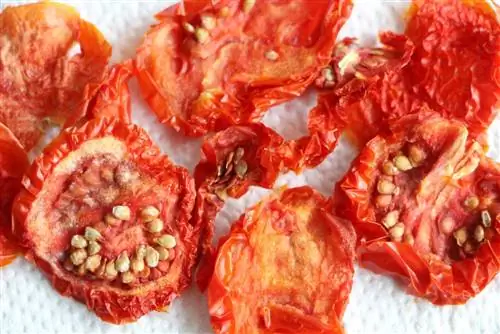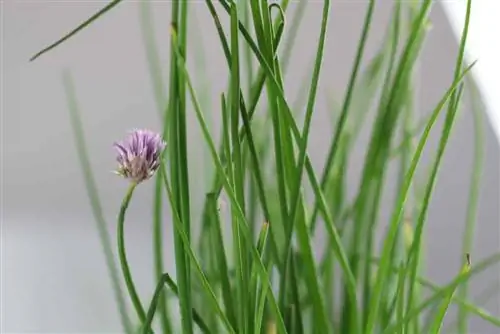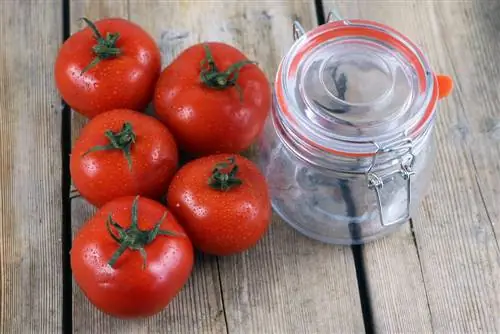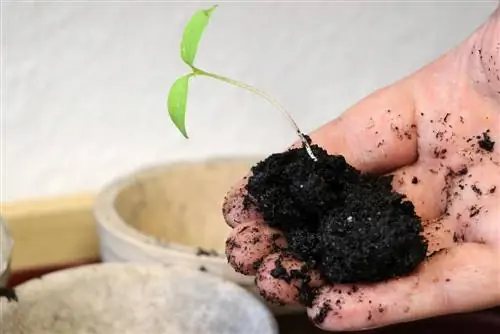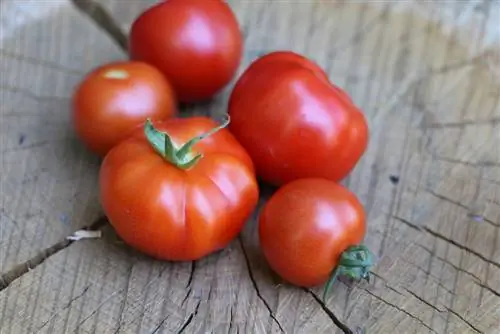- Author admin [email protected].
- Public 2023-12-17 03:39.
- Last modified 2025-01-24 12:45.
Even though tomatoes are available all year round, they are associated with summer and sun. Many people only like the round or oval tomatoes in summer because this is the harvest time for tomatoes and you bite into the full flavor. Unfortunately, summer is always too short in this country. But you can also get it in autumn and winter. One option is dried tomatoes, whose smell and taste are reminiscent of the warm season.
Red and round
Tomatoes, like potatoes, peppers or eggplants, belong to the nightshade family. Today there are several thousand varieties: yellow, orange, green or classic red. The variety of tomatoes is hard to beat. However, not every variety is suitable for drying. Small-fruited varieties in particular are not particularly suitable for drying because internal drainage is difficult to control. Green tomatoes should also not be dried.
Tip:
It is best to use normal red tomatoes or beefsteak tomatoes for drying.
Drying options
There are various options available for drying tomatoes:
- Dehydrator
- Oven
- Air and sun
- Microwave
Depending on the drying process, the tomatoes need to be prepared differently. The duration of the drying process also varies. It is considered finished when the tomatoes bend like rubber.
Tip:
To ensure that dried tomatoes have a full aroma, only fully ripe tomatoes without green spots should be dried.
Dehydrator
Dehydrators or dehydrators usually consist of a small heater with a circulating air function. There are several sieve grids inside. It is practical if the dehydrator has a temperature controller and a timer.
Preparations for drying
Before the tomatoes go into the dehydrator, they must be peeled. Cut the tomato peel crosswise opposite the green stem base. Then place the tomatoes in boiling water for 20 to 20 seconds until the skin begins to loosen. After quenching the tomatoes with ice water, the peel can be carefully removed with your fingers. Finally, cut out the stem end.
Since tomatoes are never dried whole, they must be cut before drying.
- Cut beef tomatoes into slices (5 millimeters)
- Quart medium tomatoes
- Halve the cocktail tomatoes
Tip:
If you want, you can scoop out the tomato seeds. This speeds up the drying process.
Dörren
So that the tomatoes don't stick to the sieve grids of the dehydrator, the grids can be brushed with olive oil.
- Spread the tomatoes around one centimeter apart
- sprinkle with s alt (also sea s alt) and pepper
- season with other herbs to taste
- Let dry for 8 to 12 hours at 60 to 75 degrees Celsius
It is recommended to check the process every hour. This way you can see the progress and, if necessary, regulate the temperature.
Drying in the oven

There are two options when drying in the oven. The difference lies in the level of temperature and the peeling process.
Drying with roasting
In this variant, the tomato pieces are placed on a greased baking tray after seasoning (s alt, pepper, herbs to taste). Alternatively, each piece can be brushed with olive oil.
Now the tomatoes are roasted in the preheated oven for around 30 minutes. Then take the tomatoes out of the oven and peel them.
Drying
To dry, reduce the oven temperature to 150 degrees Celsius. Place tomatoes on the baking sheet and dry for three to four hours. The tomato pieces must be turned every thirty minutes. If they have a leathery consistency, the tomatoes are ready.
Tip:
When turning over, you can also pour out the accumulated water.
Drying without toasting
When drying in the oven without roasting the tomatoes first, the tomatoes are dried with their skins on.
Preparation
Halve the tomatoes and then remove the juice, seeds and stem. Then place the tomato halves, cut side down, on kitchen paper and dry well. Then turn the tomatoes over again and place them with the cut side up on an oven rack or oven tray lined with baking paper. The halves are then s alted with sea s alt.
Tip:
Make sure they are drying tomatoes that are roughly the same size. So the process takes about the same time for all halves.
Drying
Place the oven rack or tray with the s alted tomatoes in the oven preheated to 90 degrees (top and bottom heat). The tomatoes stay there for five to six hours. They are ready when no more moisture escapes when you press your finger. To prevent moisture from getting trapped in the oven, insert a wooden spoon into the oven door. This way it stays open a little and the moisture can escape.
Tip:
Depending on the type of tomato and the oven temperature, the drying process can last into the night. If you want to sleep peacefully, you can turn off the oven overnight and continue drying the next morning.
Sun-dried tomatoes
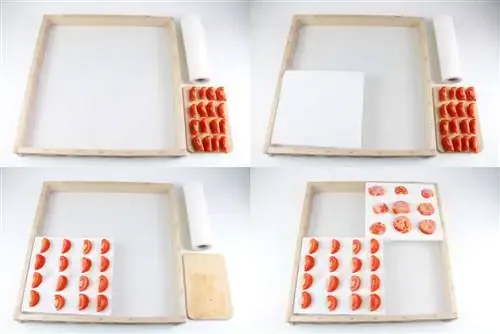
If the weather is hot and dry in summer, tomatoes can also be dried by the sun in this country. As with the other options, the tomatoes must first be cut but not peeled. Then do the following:
- place cut side down on a wire rack
- spread a close-meshed net over it to protect against birds or other pests
- place in a sunny location with good air circulation
- bring grating into the house overnight or when it rains
If the weather cooperates, the tomatoes will be dried in around three days. To ensure that they dry evenly, the tomatoes must be rotated again and again.
Drying in the microwave
Even if you can't fit as many tomatoes in the microwave as you can on a baking tray, you can basically use it to dry tomatoes.
Preparation
Halve the tomatoes, dry and s alt. When drying in the microwave, be sure to remove the juice and seeds, as any additional moisture will delay the process. Place s alted tomato halves on a round wire rack.
Drying
Place the rack with the tomatoes in the microwave. Heat tomatoes at full power for two minutes. Then open the door so that the moisture can completely escape. Then let the tomatoes dry in the microwave at the lowest power for 20 to 30 minutes. To allow moisture to escape during this time, the door must be opened every two minutes.
Conclusion
Of the drying methods described, drying in the oven without roasting is the easiest because you already have all the utensils at home. A dehydrator or device leads to great success, but you have to consider whether it is worth purchasing. If you choose an automatic dehydrator, it should definitely have a temperature control. The most natural way to dry tomatoes is certainly the sun-drying method. Unfortunately, in this country there is too little reliance on the sun for drying tomatoes. The idea with the microwave is funny, but far too complicated compared to the result. So our test winner is the good old oven.

